Making common and exotic salts with colloidsColloids are known as a reliable model system for investigating, at the level of the individual particles, phenomena that occur in solids and liquids. Researchers of the Dutch physics organization FOM and Utrecht University (The Netherlands) recently succeeded in creating a new colloidal system of oppositely charged particles, which shows equilibrium phase behavior, such as the formation of crystals. This can for instance be used to imitate the behavior of salts. One of the attractive features of the model system is the ease of investigation and manipulation of the relatively large colloids, as compared to the smaller ions of real salts. The new system immediately led to some surprising observations, including the appearance of rather exotic crystals. The investigators also made the crystals melt, by applying an electric field. This field-induced melting was accompanied by the formation of special patterns. The newly discovered colloidal structures may find their way to applications as photonic crystals and as electronic ink (‘e-ink’) for displays. The researchers will publish their results in the September 8th (2005) issue of Nature and in a paper that has been submitted to the journal Physical Review Letters. Colloids are particles with a size on the order of 1/1000-th of a millimetre, roughly a thousand times larger than atoms. The biggest ones are easily observable with a light microscope. Exactly one hundred years ago, Albert Einstein laid down the theoretical foundations for the use of colloids as a model system in condensed matter research, which involves the study of liquids, solids and their transitions, among other topics. A deep analogy exists between the behavior of atoms or molecules and that of colloidal particles. Nowadays, colloids are increasingly often used to investigate at the single particle level processes such as melting and freezing of molecules, using microscopy. The development of techniques that can distinguish and track individual colloidal particles, realized about ten years ago in the group of Alfons van Blaaderen, made an important contribution to this field. Note that a similar experimental technique for the visualization of individual molecules does not yet exist. In order to gain an understanding of atomic processes while using much larger colloidal particles, it is necessary that the interactions between the colloids resemble those between atoms and molecules. For atoms the interactions are determined by quantum mechanics, but for colloids the interactions can be tuned through chemical changes on their surface. These modifications can be controlled well. In this way, a variety of systems has been investigated already, for instance particles that repel each other upon approach or particles that attract each other when they come very close together. Imitating ionic crystals… Until recently, however, none had succeeded in imitating the interactions between positively and negatively charged atoms (‘ions’), as found in kitchen salt for instance. The charges of the colloidal particles never could be kept sufficiently low, leading to attractions between the plus- and minus particles that are too strong. This prevents the particles from forming the desired equilibrium structures, such as well-ordered crystals; instead, irregular clusters, so-called ‘aggregates’ form (these can nevertheless be nice to look at, see figure 1).
With their experiments, the two main authors of the Letter* in Nature, Mirjam Leunissen and Christina Christova, both PhD-student in the group of Alfons van Blaaderen at Utrecht University, have now shown that it actually ís possible for colloids to form crystals resembling those of salts (‘salts’ is the generic name for all solids that consist of ions). Due to their size the particles in the crystal can be imaged in a very detailed way and the exact three dimensional structure can be easily unravelled (see for example the colloidal salt in figure 2, which has the caesium chloride structure). Although this finding enables a more detailed study of processes such as crystallization and glass formation of salts, there also exists an intriguing difference between the colloidal and atomic salts. In an atomic salt crystal the total charge of all ions taken together always has to be zero, but this strict requirement does not apply to a colloidal salt, as the surrounding solvent compensates for any charge difference. As an example, positively charged particles with +40 charges each, together with negatively charged particles of -80 charges each easily form structures like that of caesium chloride, in which the number of each of the two particle species is the same. Besides enhancing the formation of common salt structures, this special feature induces a variety of more exotic crystals. Figure 3, for instance, shows a crystal in which every large particle is surrounded by no less than six small particles. The Letter in Nature presents a couple of these special crystals, whereas computer simulations by Antti-Pekka Hynninen (under the supervision of Marjolein Dijkstra) and theoretical calculations by René van Roij, which are also described in the Letter, predict many more new structures. These results will be elaborated on in another article, which has been submitted to Physical Review Letters. A few of these newly predicted structures, some of which have never been observed before, have recently been found experimentally too. This is remarkable, as only two different size ratios of the particles have been investigated yet.
…and melting them again The investigators also demonstrate how they can melt the crystals in a controlled way by applying an electric field. In this process, the plus particles move towards the negative electrode, while the minus particles move in the opposite direction, towards the positive electrode. For an atomic salt crystal this would require an unfeasible high field, but for colloidal crystals a much lower field strength suffices already. This is because the strength of a crystal is mainly determined by the number of bonds between the particles per unit volume. The colloids are a thousand times bigger than atoms and therefore this density now is a billion times smaller than in a ‘real’ salt crystal. Thus, the colloidal crystals are ‘soft’: they easily fall apart, under the influence of the aforementioned electric field or, for instance, by shaking. Hence the denotation ‘soft condensed matter’. When the particles are moving fairly fast in opposing directions another interesting phenomenon occurs: particles moving in the same direction group together, giving rise to a pattern of stripes. In this specific case the pattern formation happens far from equilibrium, with the electric field pulling hard on the particles (there are other types of pattern formation that occur near equilibrium). Theoreticians have predicted this ‘lane formation’, but it had not been observed before in experiments (an everyday analogue is formed by streams of pedestrians walking in opposite directions). The new, oppositely charged particles make it possible to study this kind of phenomena in great detail. What about applications? The interference colors in figure 4 suggest that the new colloidal crystals are possibly suitable for applications, for example as photonic crystals. Photonic crystals can switch light in the same way as transistors switch electrons. The colloidal salts offer interesting new opportunities in this respect, as they allow for many new structures and they enable the production of crystals from particles that are bigger than those used before (see figure 2 and 3).
The new structures and their sensitivity to electric fields are also promissing for display applications, such as electronic ink (‘e-ink’). One of the current kinds of e-ink consists of differently colored, oppositely charged particles, that are pulled apart by an electric field in order to switch the pixels of a display. These particles aggregate however, leading to monochromatic displays. Clearly, the beautifully colored crystals of figure 4 could offer interesting new possibilities. *‘Ionic colloidal crystals of oppositely charged particles’, Mirjam Leunissen (FOM), Christina Christova, Antti-Pekka Hynninen (FOM), Patrick Royall (FOM), Andrew Campbell (FOM), Arnout Imhof, Marjolein Dijkstra, René van Roij (FOM) and Alfons van Blaaderen.
Additional note: More information can be obtained from prof.dr. Alfons van Blaaderen, Utrecht University, The Netherlands, e-mail A.vanBlaaderen@phys.uu.nl, phone +31(0)30-2532204 or drs. Mirjam Leunissen, e-mail M.E.Leunissen@phys.uu.nl, phone +31(0)30-2532315.
|
|
| modified: 25-04-2018, 12.38 |
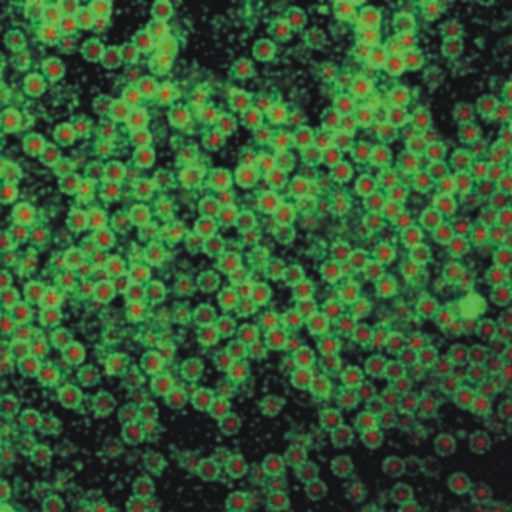 Figure 1:
Image made with a confocal fluorescence microscope showing aggregates of large, negatively charged particles (red) and smaller, positively charged particles (green). The particles, which were developed in Utrecht, emit light because of the fluorescent dye that was built in. The red particles have a diameter of about 1 micrometer, whereas the green particles are three times smaller.
Figure 1:
Image made with a confocal fluorescence microscope showing aggregates of large, negatively charged particles (red) and smaller, positively charged particles (green). The particles, which were developed in Utrecht, emit light because of the fluorescent dye that was built in. The red particles have a diameter of about 1 micrometer, whereas the green particles are three times smaller.
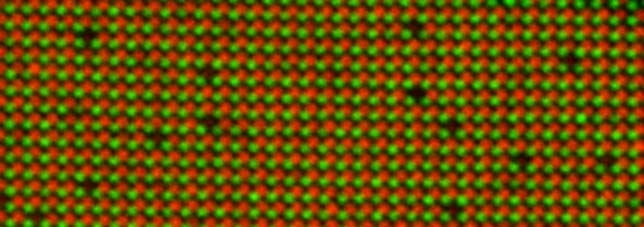 Figure 2:
Confocal microscopy image of positive (red) and negative (green) particles, together forming a crystal with the same structure as the salt caesium chloride (the particles are 2 micrometers in diameter). The red particles carry approximately 110 positive charges and the green particles 75 negative charges.
Figure 2:
Confocal microscopy image of positive (red) and negative (green) particles, together forming a crystal with the same structure as the salt caesium chloride (the particles are 2 micrometers in diameter). The red particles carry approximately 110 positive charges and the green particles 75 negative charges.
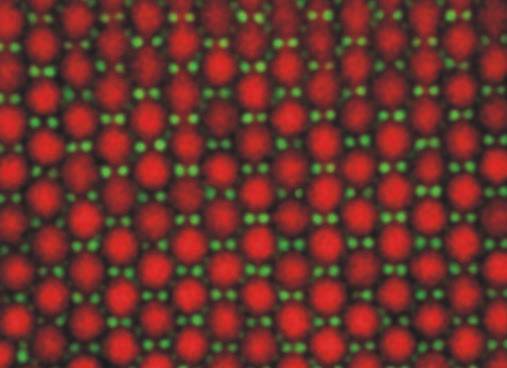
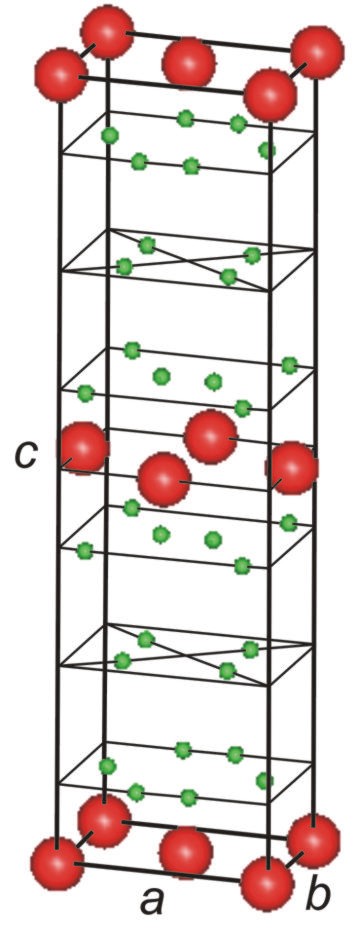 Figure 3:
Confocal micrograph of a crystal plane consisting of negative particles with a diameter of 1 micrometer (red) and positive particles that are three times smaller (green). In this colloidal salt crystal every big particle is surrounded by six small particles. The model shows the three dimensional structure of this crystal.
Figure 3:
Confocal micrograph of a crystal plane consisting of negative particles with a diameter of 1 micrometer (red) and positive particles that are three times smaller (green). In this colloidal salt crystal every big particle is surrounded by six small particles. The model shows the three dimensional structure of this crystal.
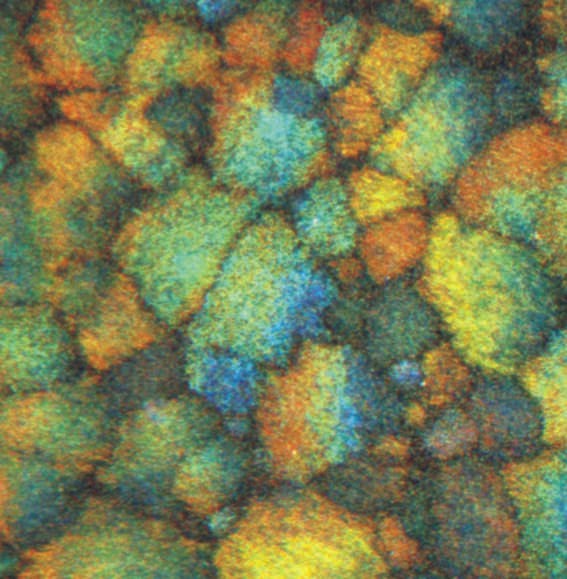 Figure 4:
When a collection of colloidal salt crystals with the caesium chloride structure is illuminated by a white light source beautiful interference colors appear (in the same fashion as the colors of the semi-precious gemstone opal come about).
Figure 4:
When a collection of colloidal salt crystals with the caesium chloride structure is illuminated by a white light source beautiful interference colors appear (in the same fashion as the colors of the semi-precious gemstone opal come about).